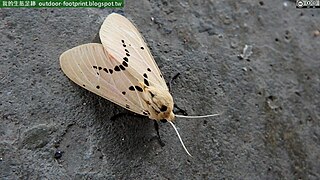
Spilarctia is a genus of moths in the family Erebidae. The genus was erected by Arthur Gardiner Butler in 1875.

Theretra indistincta is a moth of the family Sphingidae.

Spilosoma alberti is a moth of the family Erebidae. It was described by Walter Rothschild in 1914. It is found on Papua New Guinea, where it is restricted to mountainous areas at high altitudes ranging from 1,200 to 2,150 meters.
Araeomolis haematoneura is a moth of the family Erebidae. It was described by entomologists James John Joicey and George Talbot in 1916. It is found in Colombia. The type material was collected in September 1909 near San Juan on the Chocoan slopes at an altitude of 4,600 feet (1,400 m).
Lambula hypopolius is a moth of the family Erebidae first described by Walter Rothschild in 1916. It is found along the coastline of northern New Guinea, from Papua New Guinea and Karkar Island to Batanta Island.
Spilarctia grandimacula is a moth in the family Erebidae. It was described by Rob de Vos and Daawia Suhartawan in 2011. It is found in Papua and Papua New Guinea. It has been recorded from the Central Mountains in western Papua, east into Papua New Guinea.
Spilarctia mastrigti is a moth in the family Erebidae. It was described by Rob de Vos and Daawia Suhartawan in 2011. It is found in Papua and Papua New Guinea.
Spilarctia transversa is a moth in the family Erebidae. It was described by Rob de Vos and Daawia Suhartawan in 2011. It is found in Papua New Guinea and Papua, where it seems to be restricted to the Central Mountain Range.
Spilarctia hampsoni is a moth in the family Erebidae. It was described by James John Joicey and George Talbot in 1916. It is found in Papua and Papua New Guinea.
Spilarctia styx is a moth in the family Erebidae. It was described by George Thomas Bethune-Baker in 1910. It is found in Papua, Indonesia.
Spilarctia nana is a moth in the family Erebidae. It was described by Rob de Vos and Daawia Suhartawan in 2011. It is found in Papua and Papua New Guinea. The habitat consists of mountainous areas.
Spilarctia costata is a moth in the family Erebidae. It was described by Jean Baptiste Boisduval in 1832. It is found in Papua, Papua New Guinea and on the Bismarck Archipelago.
Spilarctia arctichroa is a moth in the family Erebidae. It was described by Herbert Druce in 1909. It is found in Papua and north-western Papua New Guinea. The habitat consists of lowland and mountainous areas.
Spilarctia dinawa is a moth in the family Erebidae. It was described by George Thomas Bethune-Baker in 1904. It is found in Papua and Papua New Guinea. The habitat consists of low and moderate altitudes.
Spilarctia kebea is a moth in the family Erebidae. It was described by George Thomas Bethune-Baker in 1904. It is found in New Guinea, where it has been recorded from Papua and Papua New Guinea.
Spilarctia owgarra is a moth in the family Erebidae. It was described by George Thomas Bethune-Baker in 1908. It is found in New Guinea. The habitat consists of mountainous areas.
Spilarctia rubribasis is a moth in the family Erebidae. It was described by James John Joicey and George Talbot in 1916. It is found on New Guinea, where it has been recorded from the Arfak Mountains, Kobowre Mountains and the Jayawijaya Mountains in Papua.
Spilarctia ruficosta is a moth in the family Erebidae. It was described by James John Joicey and George Talbot in 1916. It is found on New Guinea. It is endemic to the Arfak Mountains in Papua.
Orientozeuzera caudata is a moth in the family Cossidae. It was described by James John Joicey and George Talbot in 1916. It is found in New Guinea. There are also records for Japan, Malaysia, Indonesia and the Solomon Islands, but these refer to Orientozeuzera rhabdota. The habitat consists of lowland areas.
Avatha spilota is a species of moth of the family Erebidae first described by James John Joicey and George Talbot in 1917. It is found in Papua, Indonesia, where it has been recorded from the Anggi Lakes, Mount Goliath and the Pass Valley.


